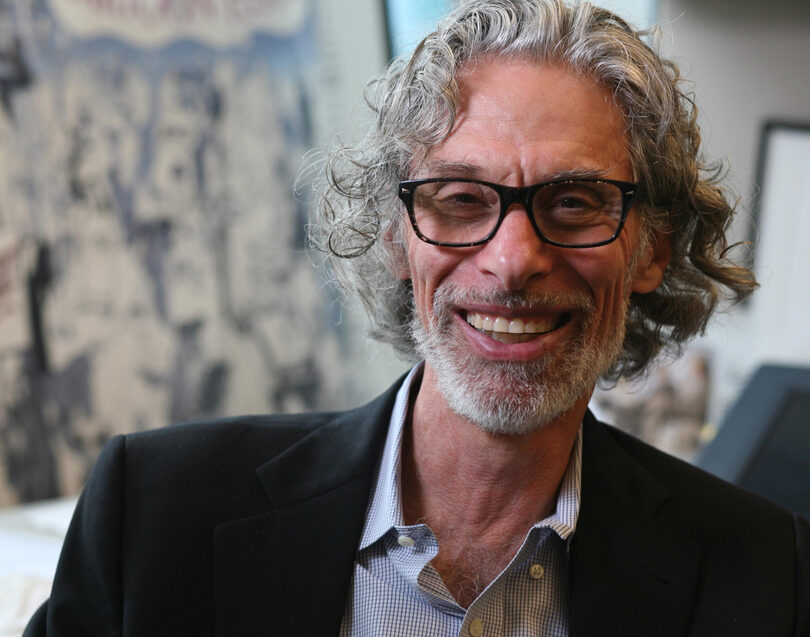Bob Mankoff draws on cartoonist career for A&S Maxwell Alumni Keynote

Cartoon artist and Syracuse University alumni, Bob Mankoff, will speak at this year’s convocation. During his time at SU, he embraced his funny, childish humor and being authentically himself ended up paying off. Courtesy of Bob Mankoff
Get the latest Syracuse news delivered right to your inbox.
Subscribe to our newsletter here.
Bob Mankoff’s life revolves around drawing.
For as long as he can remember, he’s doodled and copied his favorite superhero comics, distorting and manipulating them with his childish humor. His first cartoon, Robby the Robot, combined the science fiction character with a pinball machine. People around him found them funny.
Still, Mankoff never imagined it would become his career.
“I never thought I’d do anything,” Mankoff said. “I thought I would be a child forever and live in paradise drawing or playing basketball or eating ice cream.”
Mankoff graduated from Syracuse University in 1966. During his decades-long cartoon career, he was the cartoon editor for The New Yorker for nearly 20 years before working as the humor editor for Esquire. Now, he’s the cartoon editor for Air Mail. When SU Chancellor Kent Syverud called Mankoff and asked him to deliver the Alumni Keynote at the 2025 College of Arts and Sciences | Maxwell Convocation in May, Mankoff responded, “It’s about time.”
Growing up in Queens, Mankoff’s life was his city block. He took a bus and three trains every day to get to class at the High School for Music and Art (now Fiorello H. LaGuardia High School of Music & Art and Performing Arts). At the performing arts school, he was exposed to others who drew, many of whom were much more talented than him, he said. His humor set him apart, though.
SU gave Mankoff a place to reinvent himself and burst from the sheltered environment of his home in Queens.
For him, that meant cutting class and pulling pranks. He was kicked out of Dellplain Hall during his freshman year for burning his underwear in a can instead of doing laundry. As a protest to the dining hall’s dress code that required socks, he painted his feet to look like he was wearing them.
My personality was a force. I definitely wanted to be funnier than anyone else and I devoted a lot of time to that.Bob Mankoff, 2025 Alumni Keynote speaker
In the few times he attended class, Mankoff used humor to his benefit. When he arrived late for his social psychology final, in shorts and with weights on his feet, the professor came up to him and asked, “Who the hell are you?” Mankoff promptly responded, “I could ask you the same thing,” and the room, including his professor, erupted into laughter.
“I don’t even think he failed me,” Mankoff said. “It was the assertion of my independence. My mantra is, ‘Leave no joke unjoked.’ Don’t think it. Say it. What’s the worst that could happen?”
After graduation, Mankoff had to find something to do. The beginning of his professional career was powered by a drive, and a lot of luck, he said. But through admitting his shortcomings, he combined his humor and knowledge of the world into a successful profession.
“I was a complete f*ck up. I was a horrible employee for any reasonable thing, but I was funny and I could draw,” Mankoff said. “Basically after Syracuse, I never worked a day in my life.”
For Mankof, it’s important that cartoonists can make a living from their craft, Paul Noth, who worked under Mankoff at The New Yorker, said. At The New Yorker, Mankoff created the Cartoon Bank, a platform where he scanned rejected cartoons from the publication and faxed them to people who wanted to license them so those cartoonists could make money.
In 1997, The New Yorker bought the Cartoon Bank and hired Mankoff as cartoon editor. Mankoff had three big goals for the role: make money for the magazine and artists, create funnier cartoons and bring in a new generation of cartoonists with a “diversity of ideas.”

Bob Mankoff, Syracuse University alumni and cartoon artist, began sketching from a very young age. His illustrations, usually centered around humor, led him to become cartoon editor of The New Yorker Courtesy of Bob Mankoff
Some cartoons are autobiographical and personal, others are general or observational. Either way, cartoonists’ opinions and life experience shape their lens of humor and the cartoons they create, Mankoff said. As cartoon editor, he prioritized platforming various perspectives and moved away from publishing his own work.
Prior to Mankoff’s tenure, getting to see the cartoon editor was exclusive. Mankoff changed that. On Tuesdays, he opened his office to the hundreds of people who wanted to speak with him. He wanted to hear from and mentor new people.
Noth credits Mankoff with shaping his cartoon career. He loved cartoons growing up, but never imagined they would become his job until Mankoff took interest in his work. When Noth was hired, Mankoff told him, “I want to see 10 (cartoons) a week from you even if they’re sh*t.”
Noth followed Mankoff’s words religiously. He said the advice led to him truly becoming a professional. It kept him from being a perfectionist, and forced him to continue creating.
Aside from this initial instruction, Mankoff usually didn’t give specific directions. Instead, he offered his expertise subtly and let the cartoonists figure it out themselves through trial and error. Soon, the cartoonists learned what he was looking for and which of his pet peeves to avoid — for example, no wordplay.
“He never in any way prescriptively told us how to do this job,” Noth said. “He did not want to control us. He did not want to dictate.”
When Jay Fielden became the editor-in-chief of Esquire in 2016, he wanted Mankoff as his humor editor. His goal was to revamp the magazine’s cartoon section, which it had given up on decades ago.
Fielden and Mankoff worked together at The New Yorker, and Fielden was certain hiring a veteran cartoonist like Mankoff was “the only way it could ever have been a success,” he said. Together, they brought cartoons back to the magazine over the two years Mankoff worked there.
Mankoff’s cartoons have vast subjects and themes, addressing everything from particle physics to why men wear skinny ties, Fielden said.
“He’s not just a funny guy,” Fielden said. “He has a deeply insightful sense of humor as a mechanism in the way we communicate with each other and what it means in different situations and at different times. The Bobster. He’s a legendary guy.”
Humor is an essential part of Mankoff’s life. The laughter that punctuates conversations with friends is mandatory, he said.
“We can’t actually be stably serious all the time,” Mankoff said. “It’s a constant part of us that needs play, some kind of fooling around.”






